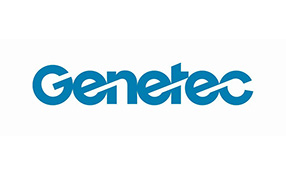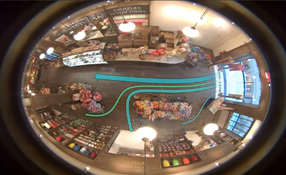Prism Skylabs - Experts & Thought Leaders
Latest Prism Skylabs news & announcements
Genetec will also demonstrate the security solutions portfolio alongside its industry hardware and software partners at the event Genetec™, a manufacturer of unified IP security solutions, will attend the ASIS 2015 seminar in Anaheim, CA (Sept. 28—Oct.1) on Booth # 2639. The company will demonstrate its full product portfolio of security solutions alongside its many industry hardware and software partners, and will unveil new features for Security Center 5.4, its unified security platform that combines access control, automatic license plate recognition (ALPR) and video surveillance. This latest release will introduce advanced logical security and video encryption mechanisms, support for the H.265 video compression standard and the next-generation of the Plan Manager mapping module. Security Center 5.4 is expected to be available in Q4 2015 through Genetec™ Channel Partners. Enhanced security authentication and access Security Center 5.4 will introduce industry-leading security threat countermeasures, including new authentication and encryption methods to ensure that only authorised personnel can access their security system. To mitigate the risk of cyber-threats, such as man-in-the-middle attacks, organisations will be able to implement digital certificates to guarantee trust within the system and implement new levels of encrypted communications between all Security Center components. By establishing a secure and trusted connection, Security Center will be able to authenticate communications within the system, validating and ensuring that data and video are not exchanged with outside sources. This latest release will also allow organisations to leverage specialised third-party claims services, including Active Directory Federation Services, to authenticate and manage Security Center user credentials. New video encryption methods in Security Center 5.4 will offer advanced capabilities to ensure that live video streams and archived video can only be viewed by authenticated users, and cannot be shared with unauthorised individuals. Leveraging either AES-256 or RSA encryption standards, Security Center 5.4 will protect recorded streams, maintaining no unencrypted data, with enforced viewing permissions through the use of digital certificates. Reduced bandwidth consumption with H.265 integration This latest release will introduce advanced logical security and video encryption mechanisms, support for the H.265 video compression standard and the next-generation of the Plan Manager mapping module As organisations evaluate methods to reduce surveillance system costs and storage needs, the advent of the H.265 video compression standard promises to reduce bandwidth consumption by up to 50 percent, while also allowing them to leverage higher resolution cameras more efficiently. Security Center 5.4 is one of the first video management platforms that will offer support for H.265, and will provide integration to the Vivotek IP9171 H.265 camera. Additionally, through support for H.265-compatible video graphics cards, Genetec customers are able to benefit from the graphic processing unit (GPU) decoding to render H.265 streams more efficiently and reduce the processing load on workstation performance. Redesigned map-based command and control When responding to an incident, navigating through a large number of devices within a security system can be time consuming, particularly for operators overseeing multi-level buildings or distributed sites. Security Center 5.4 will launch a completely redesigned version of its native mapping module, Plan Manager, to assist operators in their day-to-day tasks, via a highly intuitive and visual experience. The new “Map Monitoring” task will offer a map-centric user experience, allowing operators to rapidly navigate their security environment, monitor devices and alarms, for easy system-control actions. In security operations command centres and control room environments, Plan Manager will be optimised to leverage video walls by enabling operators to span maps across multiple monitors. Genetec™ will welcome many of its hardware and software ecosystem partners in Booth #2639 at ASIS including: Camera partners: AXIS Communications, Arecont Vision, Bosch, Dahua, Oncam Grandeye, Panasonic, Pelco, Samsung, Sensity, Sony, and Vivotek; Access Control partners: ASSA ABOY, HID, Mercury Security, Salto and Suprema; Body-worn Camera partners: B-Cam and Zepcam; Infrastructure partners: BCDVideo, EMC, Pivot3, NetApp, Veracity and DDN; Analytics Systems partners: Kiwi Security, Briefcam, Agent VI and Prism Skylabs.
An average of 31% of retailers said that integration with business intelligence applications their main driver for adopting network IP According to the latest annual Centre for Retail Research (CRR) survey into the use of CCTV in retail – commissioned by Axis Communications, the global market leader in network video – over a quarter (27%) of UK retailers cite ‘integration with business intelligence applications’ as the main reason for adoption of network IP for the third year running. Similarly, across northern Europe, an average of 31% of retailers said that integration with business intelligence applications was their main driver for adopting network IP, peaking at 35% in Denmark. Of the 278 UK retailers that responded, encompassing some 20,350 stores, the data showed that 92.8% currently use CCTV with over 60% of these are planning to convert to network IP technology. ‘Quality of Image’ saw the biggest increase in priority with a 40% increase in UK respondents naming it as the most important factor when migrating to network IP. Other major drivers for the adoption of IP technology included: ‘better remote access’ (18%), ‘scalability’ (16%) and ‘reduced total cost of ownership’ (12%) – all showing an average increase compared to last year’s survey. Shift from analogue CCTV to network IP Commenting on the results, Andy Martin, retail business development manager, Axis Communications, said: “The migration from analogue CCTV to network IP continues to be of huge importance to the retail industry and will be the biggest single factor impacting on retail security as digital surveillance and network video become the standard. “The UK High Street is still the origin of the bulk of retail transactions, but unfortunately stores also carry the highest overheads, so the need to ‘sweat the assets’ is vital with surveillance systems being no exception. This is where network IP really has the advantage as it can be used to improve both service and sales, not just security, to deliver a real return on investment. “Operating on increasingly smaller margins, reducing costs are a key priority for retailers. While IP-based video “Operating on increasingly smaller margins, reducing costs are a key priority for retailers" surveillance does make a noticeable improvement in the top line and revolutionised loss prevention, the long-term aim of superior image quality should be for lowering total cost of ownership, as it enhances detection and improves forensic investigation. “I see retailers’ use of business analytics and intelligence applications continuing to mushroom in line with cloud computing and big data. With network cameras’ capability to provide higher resolution video and be connected from everywhere 24 hours a day, retailers are receiving more data from more sources. Business intelligence applications are needed to help them manage this huge amount of information, such as images and videos, and to help them interpret it into something useful. “As network video is an open platform solution, it can seamlessly allow integration with emerging technologies and therefore, transforms the surveillance camera from a forensic tool aimed at solving problems to a proactive tool designed to optimise business processes and reduce cost. This is clearly evident from the survey as nearly half of the UK retailers polled stated that queue management (49.9%) and people counting (49.2%) were the two most important non-security network IP applications that most interested them.” Highlights of the survey Professor Joshua Bamfield, director at CRR added: “The survey clearly highlights the continued move towards IP-based camera systems across the retail sector, a growing trend that is driven by the need for HD-quality images and the increased adoption and use of business-focussed analytics - two areas where IP systems demonstrate a clear advantage over older technologies. It further suggests that retailers continue to appreciate the added benefits that an IP-based system can deliver which is evident in the high convergence rate each year.” “The survey clearly highlights the continued move towards IP-based camera systems across the retail sector" Andy concluded: “Customer theft is still the biggest security challenge facing retailers at the moment, as nearly a quarter (24.2%) said that their main reason for using CCTV is to prevent or investigate theft and a huge 80% of respondents cited prevention of internal or external theft and better safety as the main driver for the use of CCTV, seeing and average fall in loss of 15%. “As a whole, the UK has embraced the benefits that CCTV can bring and this is especially true of the retail sector. Certainly for the UK, I believe that the migration to network IP has become the norm and it is no longer a question of ‘if’ but ‘when’ the technology will be adopted.” The ‘CCTV in Retail’ survey was commissioned by global market leader in network video, Axis Communications and was run in conjunction with the Centre for Retail Research in Nottingham. Now in its fourth year, it surveyed 2,200 retailers both large and small from a wide variety of sectors and attracted 673 responses from retailers in the UK, Ireland, Denmark, Finland, Norway and Sweden. The research was carried out by the CRR between July and August 2014 and follows similar Axis-commissioned surveys in 2013, 2012 and 2010. Axis Communications, along with its partners Cognimatics and Prism, will be exhibiting at stand 330 at this year’s Retail Business Technology Expo (RBTE) in London. Experts will be on hand to discuss how network video solutions can provide retailers with a whole new set of future proof tools that enable: More effective and accurate loss prevention Improved merchandising Optimised store operations Improved customer experience.
Genetec™, a manufacturer of unified IP security solutions recently announced that its flagship security platform, Security Center, now supports the Prism analytics package from Prism Skylabs, to provide cloud-based, business intelligence tools for retailers. By integrating Prism with Security Center, retailers can extend their existing video surveillance camera system to provide valuable in-store data and metrics to monitor store traffic reports, monitor customer shopping trends, and remotely inspect store merchandising and brand displays. Improved retail experience: Retailers currently rely on video management systems (VMS) to mitigate theft, protect their patrons, premises and employees, and collect video evidence to resolve claims and incidents. In the past few years, new analytics tools have become available as separate systems to assist retailers in gaining new insight on shopping patterns and behaviours. When used with Genetec Security Center, Prism allows retailers to leverage the video data from their existing security cameras to generate retail analytics while ensuring the safety of their customers and premises. By leveraging a unified security platform across their operations, retailers can to improve their customers' shopping experience, while maximising their investment in their video surveillance system. “It’s our goal to bring next-generation analytics technology to new classes of devices,” said Prism CEO and Founder Steve Russell. “Genetec is one of the best video management systems in the world, and together we offer a powerful solution for retailers.” Benefits of Prism: With built-in masking features that ensure shopper privacy, Prism analyses video camera data to generate visual activity patterns and maps. Real-time store traffic reports are also generated by Prism to help store managers determine appropriate staffing at peak periods. System-generated heat maps analyse where customers are shopping and spending most of their time to optimise shopper engagement with store merchandise and promotional activities. This helps store managers determine ideal locations of in-store displays and promotions, while mobile access to the Prism web client enables retailers to remotely view stores to ensure that operational and merchandising guidelines are followed. "Security Center is built on an open-platform specifically to welcome software partners like Prism Skylabs to extend the features and functionality of our unified IP security system," said Jimmy Palatsoukas, senior product marketing manager at Genetec. “With their focus of providing insightful business analytics and intelligence tools to the retail community, we can help our customers in this vertical maximise their security investment by enabling them to optimise in-store sales, marketing, and operational activities,” added Palatsoukas.
Insights & Opinions from thought leaders at Prism Skylabs
Many of the most well-trafficked articles posted at SourceSecurity.com in 2015 were those that addressed timely and important issues in the security marketplace. In the world of digital publishing, it’s easy to know what content resonates with the market: Our readers tell us with their actions; i.e., where they click. Let’s look back at the Top 10 articles we posted in 2015 that generated the most page views. They are listed in order here with the author’s name and a brief excerpt. 1. Video analytics applications in retail - beyond security [Larry Anderson] Analytics can help catch suspects by alerting in real-time. After the fact, analytics used for search purposes are far more effective to identify a theft. Secondly, analytics can be used in retail to track customers, understand their age and gender, manage queue lines, know how long people dwell at an end cap, provide heat maps, etc. 2. Cybersecurity - hackers target SCADA embedded systems [Vicki Contavespi] “SCADA monitors devices on the grid many times per second and was never intended or designed to have virus protection or security protocols,” says Dave Hunt, an independent homeland security consultant and a founding member of the National InfraGard Electromagnetic Pulse special interest group. In fact, continuous monitoring makes it virtually impossible for a SCADA system to validate a security protocol. 3. Home automation standards and protocols [Randy Southerland] As the home automation industry has expanded with an ever-growing number of devices and services, companies are placing bets on which wireless protocols will dominate. The past few years, the leaders have been Z-Wave and ZigBee. Companies are also using a variety of other standards including Crestron’s Infinet, Insteon, and proprietary technologies such as Lutron’s ClearConnect. Readers were interested in Prism Skylabs' retail applications, utilising IP cameras as sensors to gather data on customer behaviour 4. The numbers tell the video story at ISC West: 4K and H.265 [Larry Anderson] The latest in video surveillance equipment at ISC West [in 2015] is reflected by the numbers you hear repeatedly on the show floor, numbers like 4K and H.265. Big players like Panasonic have joined the 4K bandwagon in a big way. Sony introduced a 4K camera with a larger sensor size (1-inch) to increase light sensitivity, displaying the better view alongside a “Brand X” competitor in the Sony booth. 5. Video analytics: Prism Skylabs envision IP cameras as sensors to expand their role in retail [Larry Anderson] Prism Skylabs is helping to drive a re-evaluation of the role of video cameras in the market. Founded in 2011, the San Francisco cloud service company thinks of IP cameras as sensors that are capable of providing a range of data that can be managed and processed in the cloud to provide more useful information to end-user customers. Prism’s current implementations of the “software as a service” approach focuses on retail merchandising and marketing applications, but Prism Co-Founder and Senior Vice President Bob Cutting sees many other opportunities too. 6. Video analytics for forensics: Analytics-based forensic evidence collection [Larry Anderson] Another aspect of video analytics is how the technology can be used for forensics. Basically, intelligent searches of video archives provide investigators faster access to any needed video clip based on the content of the video. It’s a monumental improvement over the old days of searching for hours while rewinding and fast-forwarding videotape. 7. IP video surveillance market – revealing the ‘industry standards’ myth [Mark Collett] Considering the state of the IP surveillance industry, standardisation would likely drive vendor consolidation and force companies to evolve in order to succeed. Many industries have successfully implemented standards – including energy, telecommunications, consumer electronics and aerospace. These are all vibrant industries; standards have not driven any of them to extinction, as some in the security industry believe they would. Another topic of interest was the public and private protection of public figures, spurred by the Pope's visit to America earlier this year 8. Physical Security Information Management (PSIM) – the death of an acronym? [Larry Anderson] Lately, we have even begun hearing manufacturers starting to avoid the PSIM term and its historic baggage and preconceptions. When a buzzword takes on a negative stench, it loses its impact. If a PSIM is perceived as negative, the initials lose their usefulness even as a marketing term (which some say PSIM was all along). 9. Avigilon acquires fundamental patents covering video analytics [Larry Anderson] What are the ramifications when a major supplier in the video analytics space owns many of the patents that are fundamental to its competitors’ businesses? It’s one thing to pay licensing fees to a fading player like ObjectVideo (perhaps to avoid costly litigation?), but isn’t paying those fees to a direct competitor another matter? 10. How public and private security operations protect celebrities, big-name executives and dignitaries [Michael Fickes] According to the Secret Service, dozens of federal, state and local agencies combined forces to protect the Pope in his visits to Washington, D.C., Philadelphia and New York City. The Department of Homeland Security designated the Papal visit to New York City a National Special Security Event. For such an event, the Secret Service acts as the lead federal agency for the design, implementation and oversight of the operational security plan. See the full coverage of 2015/2016 Review and Forecast articles here
We all know that security video cameras are becoming smarter. The IP cameras at the edge of today’s video surveillance systems contain computer chips that can potentially change how cameras are used. However, despite the changing technology and greater intelligence at the edge, today’s systems mostly use video cameras for one thing – to provide video. In some cases, the cameras provide hours and hours of video that no one will ever watch. Re-examining the role of video cameras Prism Skylabs is helping to drive a re-evaluation of the role of video cameras in the market. Founded in 2011, the San Francisco cloud service company thinks of IP cameras as sensors that are capable of providing a range of data that can be managed and processed in the cloud to provide more useful information to end-user customers. Prism’s current implementations of the “software as a service” approach focuses on retail merchandising and marketing applications, but Prism Co-Founder and Senior Vice President Bob Cutting sees many other opportunities too. The cloud infrastructure provides a “reliable and continuously connected way to monitor and get data from cameras that is extremely robust and reliable,” Cutting says. Information from cameras “trickles up” to the cloud where data is “pre-extracted and available,” helping retailers optimise their store designs and marketing. Prism provides a blend of complementary visual and analytics data. "We looked at the camera andreimagined what it can do as a realsensor – a sensor with intelligencethat is cloud-ready, cloud-enabledand easy to install. How we think ofvideo has to change" Retail applications of video analytics In the retail world, the approach enables marketers and merchandisers to constantly observe and monitor retail displays and customer activity from around the world in real time. Store owners can tell, for example, if their stores opened on time. Did a new product launch effectively? “There are hundreds of questions that retailers want to answer, and they don’t want to watch streaming video from the store,” Cutting says. “They just want answers to questions.” He says the system provides “an easy way to navigate and access data.” If you think of a camera as an intelligent sensor, the data provided by that sensor can take many different forms (and only one of them is “streaming video,” which may not be the most useful for a specific end user need). Cutting says the data is “privacy enabled,” and does not contain personal information. Integrating with CCTV manufacturers Prism has integrated its cloud system with cameras from Digital Watchdog, and announced integration with Axis cameras at the recent ASIS International show in Anaheim. The company is also in the process of integrating with several other large camera manufacturers in the video surveillance market. Employing intelligent cameras at the edge, the company “saw overnight a shift from server-based solution to an edge-based camera solution.” “It’s the right form factor,” says Cutting. “We looked at the camera and reimagined what it can do as a real sensor – a sensor with intelligence that is cloud-ready, cloud-enabled and easy to install. How we think of video has to change.” Role of video analytics in store security Security cameras are capable of providing up to a dozen additional outputs, combining data with visual elements, says Cutting. For example, intelligent cameras can count people, and can track movement of customers in a store based on defined rules. An end user can know how many people go down a certain aisle, how long they dwell in front of a display, how many people visit a certain area in a given time. Cameras can also provide “visual summaries” of activity in a store, showing graphically who went where over a certain period of time, providing retail traffic maps, heat maps, and other visual outputs to guide store owners and managers. Cameras can also provide “visualsummaries” of activity in a store,showing graphically who wentwhere over a certain period of time,providing retail traffic maps, heatmaps, and other visual outputs toguide store owners and managers Finally, cameras can provide a variety of visual data (in addition to streaming video). These include video snapshots (high-resolution images taken periodically and delivered in high resolution to the cloud). Visual outputs might also include “background models,” which are images of retail shelves presented without the customers moving in front of them to provide a detailed view of products and how they are arranged on the shelf. There are also other types of visual outputs, such as time-lapse video, and thumbnail images taken one frame per second. In effect, the visual output is matched specifically to what the end user wants to see – and one camera can be used for multiple outputs to meet the needs of various stakeholders. (Cameras can also provide outputs focused on the needs of loss prevention and security departments.) Examples and applications of retail analytics Lolli and Pops, a 26-store candy chain, is using the system to change the candy store experience. Using the Prism Skylabs system, the company tests multiple combinations of merchandising displays, and measures the effectiveness (and maximises the benefit) of each. The company employs A/B testing – one display in one store and a different display in a second store – to measure which approach works best, in effect fine-tuning the retail experience for customers. Another Prism customer is a large retailer deploying the system throughout Europe, leveraging the system’s ability to count, provide visual insight and understanding, and real-time visibility into the effectiveness of merchandising displays (using a 25-point checklist to ensure compliance). Other potential end-markets include retail banking, hospitality and even casinos – “anyone who wants a better understanding of their space,” says Cutting. He says there is a growing opportunity for physical security integrators in the area of retail analytics, and use of cameras as sensors conforms to emerging industry trends such as “Big Data” and the “Internet of Things” (IoT). He asks: “How can we break down video into core components that are IoT-friendly and that a wider audience can use?”
One system, one card
DownloadAligning physical and cyber defence for total protection
DownloadUnderstanding AI-powered video analytics
DownloadEnhancing physical access control using a self-service model
DownloadHow to implement a physical security strategy with privacy in mind
Download













